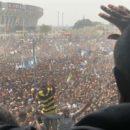The Entire Range of Misery of Civilians Caught up in War
In 2000, an interviewer brought me a data form in the Eastern DR Congo reporting that two children had died of fear during an attack. I was so incapable of imagining this, that I had the interviewer take me back to the household where this had been reported. They had three huts all within a couple meters of each other and the children had been in their hut asleep when an attack on the village began. Most people fled into the bush. Eventually, the Interahamwe rebels arrived at this household and went into the hut next door and repeatedly shot the children’s grandfather. The parents assured me that they had watched and the rebels never went into the children’s hut. After the rebels left, both children were found dead in their hut clenching each other without a scratch on them. Should these deaths be classified as physical violence? Can people die of psychological violence? I was and am incapable of classifying these deaths by any clear and simple mechanism. Since then, I have recorded this type of event twice more always with two very young children, once with twins in Kalamie DRC during a bombing raid, and in Iraq in 2004 when two children had died hugging each other on their bed as the house next door was bombed by an American plane. The very experienced Iraqi physician who was the interviewer assured me that there had been no major damage in the children’s room, which he had seen, and that they had died purely of fear. I have occasionally told friends or people I meet socially about these child “fear induced deaths” but people usually cannot even process what I am saying or speculate that people are lying to prevent retaliation from reporting that these deaths that are really from violence. I have repeatedly been struck with how people, even U.S. physicians, refuse to believe that this can occur. Over the years, I have come to realize that it is because few people in the U.S. can really understand the spectrum of horror that accompanies full-scale violent warfare. In his extraordinary book, Killing Civilians: Methods, Madness, and Morality in War Hugo Slim has captured the entire range of misery that is experienced by civilians caught up in armed conflict.

The book systematically goes through the legal constraints on killing civilians during warfare, the direct and indirect mechanisms by which they die, why people intentionally or through disinterest allow civilians to die, and how civilians could be better protected. By its outline, it is the classic systematic treatise on a rarely discussed topic which would be just another comprehensive book for the humanitarian’s collection if not for Hugo Slim. Until recently the chief scholar at the Centre for Humanitarian Dialogue, Dr. Slim has for most of two decades been a lonely voice calling for an evidence base and a system of logic in the process of humanitarian assistance. He has pointed out the NGO community is accountable to few and often is poor at listening to those they purport to serve. He talked about the militarization of the humanitarian relief system years before the issue came to the fore in Afghanistan and Iraq. As someone trained in theology, his critiques have been unique in that he is not particularly an advocate for a cause, a gender, or a particular economic system. His issues have mostly been based on ethics and pragmatism, pragmatism formed from years of working for NGO’s and the UN in conflict settings. Thus, when discussing the terror associated with bombings, he writes “…the sheer noise and repetition of explosions can create terrible panic and fear, particularly and tragically in children.” Clearly Dr. Slim would have no trouble understanding fear induced deaths. The real world experience and view of the author, brought out by dozens of personal experiences, bring this dire topic to life and make it a fascinating read.
As with most of his work, Killing Civilians strikes a balance between most of the debates within the humanitarian community. Slim does not argue for absolute separation between humanitarian and military endeavors, he does not argue for a rights-based approach of humanitarianism at the exclusion of pragmatic military needs. One area where the book tends to take a view is in the tension between the public health approach and the legal case approach of situation diagnosis, the book being from the latter view. Jennifer Leaning from Harvard has often spoken of the tension between NGOs delivering services and human rights groups in the field. One is performing services that belligerents often value and the other is operating against the belligerents interests. Moreover, information for public health needs to be representative and population-based, thus almost always is anonymous and transparent. Legal evidence requires names, places, and specific events which is what human rights activists tend to collect: incidents in lieu of incidence. Nowhere was this lens more pronounced than in the discussion of rape in war. In the six in-depth population-based studies of rape in conflict or post-conflict settings with which I am familiar, gang rape by combatants has never added up to 2% of reported rapes and combatants never accounted for more than a few percent of assailants. Instead, drunkenness and coercion by friends and family usually accounts for the majority of rapes. The social decay associated with war may trigger many of these events, but they are not what human rights groups and scholars tend to discuss, and does not arise in Killing Civilians. As a public health professional, the shortcomings of my epidemiologist and demographer peers were most revealed by Dr. Slim’s characterization of the Rwandan genocide, written from a legal perspective shared by most political scholars. I spent six weeks in Rwanda during the genocide working for the UN, mostly in areas controlled by the Rwandan Patriotic Front (RPF). Virtually all of the bodies I saw were Hutus killed by the RPF. I assumed that this image contrasted so dramatically with the reports I heard each night on the shortwave radio because I had a skewed vantage of what was happening. Years later I learned that interviews of orphans by UNICEF had concluded that most orphaned children were Hutus and that an ethnographic assessment commissioned by the U.S. State Department during the war had reached similar conclusions to mine. Thus, Hugo Slim’s call for serious study of violence against civilians in times of war rang true, since as an epidemiologist who was there, shamefully I (and I suspect no one else) can even say which side did more killing in this conflict which is most often compared with the Holocaust, perhaps the most horrific one-sided slaughter of the past century.
The closing chapter of Killing Civilians is an articulate call to undertake a series of complex social transformations to become a species that acknowledges the complexity of understanding who is a legitimate target in times of conflict while simultaneously embracing the civilian ethic. What he has proposed is hard work. We in the humanitarian community need to do more. Those who execute war need to do more. Throughout the war in Iraq, dehumanizing and insensitive language about civilians has been printed in the West on a regular basis with no protest from the readers. For example, on September 5, 2003, papers across the US, for example, the Houston Chronicle ran an article that interviewed as US soldier about the previous day. It said, “We had a great day,” said Schrumpf. “We killed a lot of people. We dropped a few civilians but what do you do?” Hugo Slim is right, we all need to do more.







I knew of one such event that someone has died of fear, a lot of people speculated and there was no other evidence supporting that that person was attacked of had committed suicide. Some said that she saw a ghost or some sort that incidence fear. Her face was horrible after the incident. A later autopsy reported that one of her gut exploded, but medical people cannot understand why, I forgot what gut it was because it was so complex. Now, I believe that these children really died from fear of the attacks. It really is justifiable that peaple can die from fear and it is not that easy to understand why.